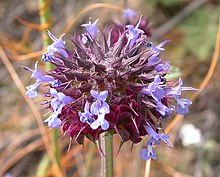Salvia columbariae: Difference between revisions
mNo edit summary |
mNo edit summary |
||
| Line 13: | Line 13: | ||
|}} |
|}} |
||
'''''Salvia columbariae''''' is an [[annual plant]] of the [[Lamiaceae]] family. It is commonly called '''chia''' or '''golden chia''' because its seeds are used in the same manner as ''[[Salvia hispanica]]'' (chia). It grows in [[California]], [[Nevada]], [[Arizona]], [[New Mexico]], [[Sonora]], and [[Baja California]] and was formerly an important food for [[Native Americans in the United States|Native Americans]]. Some native words include '''pashí''' from [[Tongva]] and 'it'epeš from [[Ventureño]]. |
'''''Salvia columbariae''''' is an [[annual plant]] of the [[Lamiaceae]] family. It is commonly called '''chia''' or '''golden chia''' because its seeds are used in the same manner as ''[[Salvia hispanica]]'' (chia). It grows in [[California]], [[Nevada]], [[Arizona]], [[New Mexico]], [[Sonora]], and [[Baja California]] and was formerly an important food for [[Native Americans in the United States|Native Americans]]. Some native words include '''pashí''' from [[Tongva]] and ""'it'epeš"" from [[Ventureño]]. |
||
== Morphology and Taxonomy == |
== Morphology and Taxonomy == |
||
Revision as of 05:07, 12 May 2010
| Salvia columbariae | |
|---|---|

| |
| Scientific classification | |
| Kingdom: | |
| (unranked): | |
| (unranked): | |
| (unranked): | |
| Order: | |
| Family: | |
| Genus: | |
| Species: | S. columbariae
|
| Binomial name | |
| Salvia columbariae | |
Salvia columbariae is an annual plant of the Lamiaceae family. It is commonly called chia or golden chia because its seeds are used in the same manner as Salvia hispanica (chia). It grows in California, Nevada, Arizona, New Mexico, Sonora, and Baja California and was formerly an important food for Native Americans. Some native words include pashí from Tongva and ""'it'epeš"" from Ventureño.
Morphology and Taxonomy
S. columbariae grows 10 to 50 cm. Its stem hairs are generally short and sparse in distribution. It has oblong-ovate basal leaves that are 2 to 10 cm long. The leaves themselves are pinnately dissected and the lobes are rounded irregularly. The inflorescence is more or less scapose, meaning it has a long peduncle that comes from the ground level that has bracts. The bracts are round and awn-tipped. There are usually 1-2 cluster of flowers within the inflorescence. The calyx is 8 to 10 mm long and the upper lip is unlobed but has 2 (sometimes 3) awns. The lower lip is about twice the size of the upper lip. The flower color can be pale blue to blue and purple tipped. The stamens of the plant are slightly exserted. The fruit of S. columbariae is a nutlet that is tan to grey in color and 1.5 to 2 mm in length.
Ecology
S. columbariae can be found in dry undisturbed sites in chaparral, and coastal sage scrub. It generally grows at elevations lower than 1200 meters. In cultivation, it needs good drainage, sun, and dry weather to grow to its fullest potential.
Varieties

- Salvia columbariae var. columbariae Benth. -- California sage, chia
- Salvia columbariae var. ziegleri Munz—Ziegler's sage[1]
References
- Hickman, James C. The Jepson Manual Higher Plants of California. University of California Press, Berkeley Los Angeles London. (1993).
- USDA Natural resources Conservation Service. [web application]. 2006. Available: [1]. (Accessed: May 25, 2006)
External links
- Salvia columbariae at Calflora
- Chia at USDA Plant Profiles
